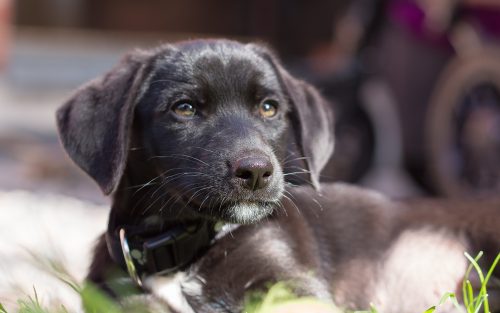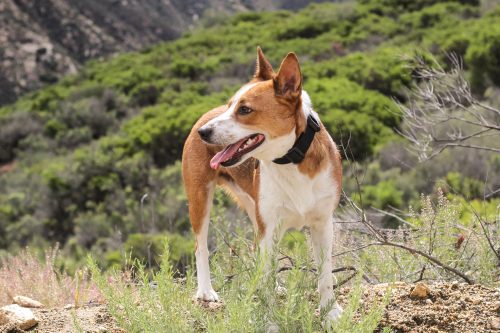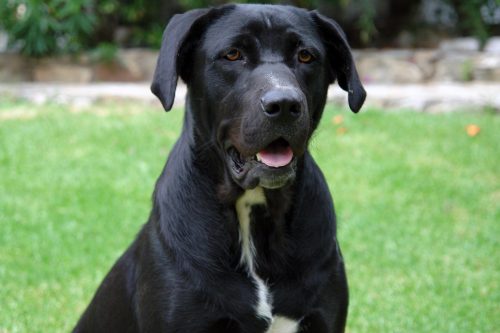The technical name for hotspot is superficial canine pyoderma, or also sometimes known as acute moist dermatitis.
In most cases, hotspots on dogs are localized to one specific area. They are the product of an overpopulation of bacteria that naturally lives on your dog’s skin. Hotspots on dogs appear to be a common issue in dogs with compromised immune systems and often times older dogs of certain dog breeds.
Hot spots on dogs are extremely painful, and seem to be more prevalent in dogs that have allergies, dog breeds that have long and thick coats (especially with fur prone to matting), and dogs with moist or dirty skin due to weather and environment.
Hotspots on dogs can appear seemingly out of nowhere. Your dog can develop them within hours in response to the inciting irritation. If not taken care of right away, the hot spot can lead to a skin infection.
What Are Hotspots on Dogs?
Hotspots are patches of itchy skin that are red and irritated. The area is often moist, which makes conditions ripe for bacteria to proliferate.
The redness and irritation is caused by your dog licking and itching and chewing the area, creating sores and bald spots, with scabbing and oozing.
These hotspots are most commonly found on the head, the neck, or the hips and the limbs. Because summertime tends to be hotter, with higher levels of humidity in the air, hotspots appear to be more prominent during the summer season.
Causes of Dog Hotspots
Unfortunately, there may be a variety of root causes for your dog’s hotspots. One of the leading culprits is an allergic reaction. This could be due to food allergies or something in the environment.
For instance, if you feed your dog a certain brand of food, you may need to evaluate the ingredients for known allergens and try a different brand.
If you feed your dog table food, you should pay close attention and notice if he has a reaction after eating something in particular.

Unfortunately, environmental allergies can be just about anything, ranging from ragweed, pollen, grasses and molds, to household products, soaps or detergents, and carpet cleaners.
Sometimes even water that’s been polluted with something or an inhalant in the air can trigger a reaction that causes hotspots.
Dogs can get hotspots due to a flea allergy too. Flea allergies occur because your dog is allergic to the saliva of the flea. In this case, even if you can’t find any fleas, just one bite can cause your dog to scratch and lick and chew furiously. If you suspect a flea allergy, you need to make sure you bathe your dog regularly with a medicated shampoo, and brush him down with a flea comb afterwards. There are many options to maintain flea control over your dog like oral medication and flea collars. It’s recommended that you speak to your veterinarian before you decide what means of flea control you go with.
Sometimes dogs get hotspots because of mental or emotional issues. Things like separation anxiety, OCD, and boredom are all behavioral problems your dog can be susceptible to, and this can be exacerbated by certain dog breeds. The disorder related to a mental illness is known as Acral Lick Dermatitis. This occurs in senior dogs of certain dog breeds. The constant licking is said to release endorphins therefore calming the older dog who may have developed a form of anxiety, stress, or boredom. Some breeds are more inclined to emotional disorders than others.
Unfortunately, regardless of breed, behavioral issues can be very difficult to treat. When these behaviors trigger your dog to chew and lick a spot obsessively, he will develop open wounds that will only spread the more your dog continues to lick and chew. Modifying the behavior is the best long-term solution, but it doesn’t always work.
Sometimes dogs can have some other underlying nerve, muscle, or bone problem that is causing them pain. A dog will often react to that pain by licking, chewing, and biting the spot that hurts.
When a dog does this, he will create a hotspot, and make his pain even worse, making it a vicious cycle. For instance, dogs that suffer from arthritis or some other health condition such as neuralgia sometimes develop hotspots. Neuralgia is a condition that causes pain and tingling in the limbs and feet. Those sensations will cause dogs to chew and bite the area, so hotspots can crop up rather suddenly.
Other possible causes of hotspots in dogs are things such as:
- Insect bites
- Cuts or scratches
- Splinters or thorns, or some other foreign item
- Anal gland infections
- Ear infections
- Matted fur and poor grooming
- Swimming
- Frequently being in the rain
How Hotspots Develop in Dogs
Hotspots develop when there is an imbalance of the bacteria Staphylococcus intermedius on the surface of the skin. This strain of bacteria is common and only becomes a problem when there is an irritation of some kind that makes your pet have itchy skin that they itch and chew the area compulsively.
When your dog itches and chews the area, the hair follicles at the site are disrupted by the bacteria from your dog’s nose and mouth.
Warm weather with high humidity, or any source of moisture and heat, as well as scrapes and abrasions can all contribute to an overgrowth of this bacteria.
It’s a vicious little circle because the more this bacterium grows, the more your dog will experience redness, itching, pain, and inflammation. Your dog’s immune system goes into overdrive and reacts to the perceived threat, and triggers licking and chewing in your dog.
Signs of Hotspots in Dogs
Hotspots can manifest anywhere on a dog, but the most common areas are basically everywhere but the trunk. Head, limbs, chest, neck, hips. Some of the signs that your dog may have hotspots include:
- Matted fur that appears moist
- Localized swelling, inflammation, and redness
- Skin that appears scaly and dry
- Sores that appear crusted or oozing
- Patches of skin that are painful to the touch
- Itchiness
- Constant licking and chewing
- Balding and hair loss in dogs
- Foul odors from infected areas
Sometimes because of the pain, dogs can also present with symptoms like depression and abnormal aggression.

Diagnosing Hotspots on Dogs
Unfortunately, hotspots can worsen fairly quickly. So, if you notice your dog is displaying symptoms, you should keep an eye on it and try an over-the-counter treatment option right away. An over the counter treatment will offer some itch relief and may prevent a skin infection due to a bacterial infection. A home remedy that’s been known to treat itchy skin, fleas, and ear infections is apple cider vinegar.
If that fails and the hotspots get worse, take your dog to a veterinarian as soon as possible as hotspots can be very painful.
Your vet will want to know when the symptoms and skin problems started, and they will ask for a complete history as well as take a complete physical exam. They may ask if there are any possible allergies or if are any unusual circumstances that could have triggered stress or anxiety in your dog.
Sometimes your vet may shave the area so that it can be properly cleaned and fresh air can reach the site. Shaving can also help your vet figure out how severe the hotspots are and assess the size of the lesions. Depending on what your vet suspects, they may order a bacterial sample or a culture sample.
Treating Dog Hotspots
Clean the Area Completely
The first step in treating hotspots is to clean the area thoroughly. Shaving is recommended, so that the site is clear of hair and the wounds can dry out. If you do not shave the dog, it can complicate the problem because his hair can become trapped with pus. This can irritate the wound further, and cause the infection to spread. Healing will also take much longer.
If the infection appears to be spreading despite your best efforts, you may need to seek help from your vet, especially if you notice your dog has a fever. You certainly don’t want the infection to spread and compromise your dog’s health any further.
Plus, because hotspots can be so painful, it may be wise to take him to the vet to have this step done, anyway. When a dog is in severe pain, sedation may be required, and that can only be administered by your vet.
Once the dog is comfortable and relatively pain-free, the area can be properly cleaned with a topical antiseptic that will remove bacteria. Povidone–iodine is a good choice that you can find at most drugstores. You can also try chlorhexidine.
The overriding goal at the beginning of treatment is to clean and disinfect the area, and keep it clean and disinfected, especially if the wound is oozing pus.
You should aim for cleaning the site at the minimum at least twice a day, and even more depending on how bad the infection is and how much pus the area produces. Keeping the area clean and dry is vital for the hotspots to heal properly.

Sometimes, depending on their findings, your vet will prescribe oral or topical antibiotics to be used for four weeks or more. Treatment of any underlying causes such as allergies will also be necessary.
For instance, if your dog is allergic to fleas it will be prudent to put him on a flea medication. If your dog bites and chews due to some sort of behavior disorder such as anxiety, you can try giving them chew toys or making sure they get more play and exercise time to burn off the excess angst.
Your vet may choose to give your dog a corticosteroid, and possibly prescribe anti-histamines for irritation and itching, and NSAIDs for inflammation.
Natural Topical Solutions for Dog Hotspots
Once you clean your dog’s wound appropriately, unless you’ve been to the vet and he has prescribed medication, you can treat the area with natural remedies like raw honey, raw aloe, and colloidal silver.
Avoid any treatments that may cause the area to burn, such as apple cider vinegar or tea tree oil. The area is already painful enough, so it’s better to provide soothing treatments.
Discourage Your Dog from Relapse
Depending upon how severe the episode was, you may or may not need to follow up with your vet. In most cases, when you keep the area clean and disinfected, and make sure your dog receives the proper treatment, hotspots will clear up quickly.
Just make sure that you are also addressing whatever the underlying root cause may be, or the hotspots will only return.

To keep your dog from licking and chewing while they are undergoing the healing process, you may have to try what’s known as an “E” or “Cone” collar.
Sometimes you can try putting a light wrap or dressing on your dog, but only if you are certain he will leave the area alone. Otherwise the E collar is the best bet to keep him from reopening wounds and preventing the area from healing.
It’s important to keep your dog from messing with the wound or it will just return and the area may grow bigger. Note that it can take a couple of weeks before you notice visible signs of healing. Fur usually starts to grow back after about a month or so.
Preventing Hotspots in Dogs
The best way to prevent hotspots is to keep your dog well-groomed on a regular basis. If your dog has very long or thick fur, you might consider keeping his coat clipped short. Especially if he is prone to matting.
Make sure your dog stays clean and dry, and if he is sensitive to fleas, make sure he is on a regular flea medication. Keep your dog’s home environment as free from stress as possible, and make sure your dog gets plenty of exercise and play time to burn off energy, and reduce boredom.
If allergies are suspected as an underlying cause, you’ll want to make sure you are treating your dog for those as well.
If it’s a food allergy, eliminate the suspected food, and if it’s an environmental allergy, narrow it down as best you can and eliminate the suspected culprits.
If your dog continues to develop hotspots even after your best efforts, then there is another underlying cause that you are missing. You will need to revisit your vet and try once more to determine the source of your dog’s skin condition.




